
A two-strokeengine is a type of internal combustion engine that completes a power cycle with two strokes of the piston during one power cycle, this power cycle being completed in one revolution of the crankshaft. A four-stroke engine requires four strokes of the piston to complete a power cycle during two crankshaft revolutions. In a two-stroke engine, the end of the combustion stroke and the beginning of the compression stroke happen simultaneously, with the intake and exhaust functions occurring at the same time.

The Honda Magna is a cruiser motorcycle made from 1982 to 1988 and 1994 to 2003 and was the second Honda to use their new V4 engine shared with the VF750S Sabre and a few years later a related engine was fitted to the VF750F 'Interceptor', the later models used a retuned engine from the VFR750F with fins added to the outside of the engine. The engine technology and layout was a descendant of Honda's racing V4 machines, such as the NS750 and NR750. The introduction of this engine on the Magna and the Sabre in 1982, was a milestone in the evolution of motorcycles that would culminate in 1983 with the introduction of the Interceptor V4. The V45's performance is comparable to that of Valkyries and Honda's 1800 cc V-twin cruisers. However, its mix of performance, reliability, and refinement was overshadowed by the more powerful 1,098 cc "V65" Magna in 1983.

In automotive engineering a multi-valve or multivalve engine is one where each cylinder has more than two valves. A multi-valve engine has better breathing and may be able to operate at higher revolutions per minute (RPM) than a two-valve engine, delivering more power.
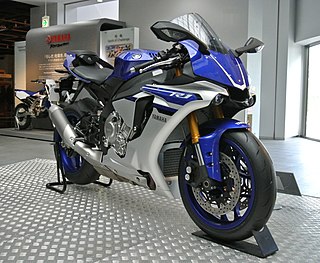
The Yamaha YZF-R1, or simply R1, is a 998 cc (60.9 cu in) sports motorcycle made by Yamaha. It was first released in 1998, undergoing significant updates in 2000, 2002, 2004, 2006, 2007, 2009, 2015, 2018 and 2020.
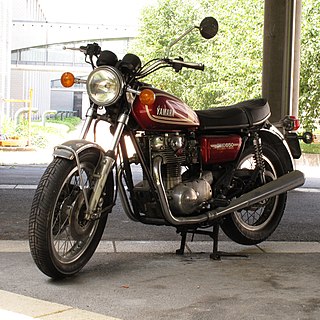
The Yamaha XS650 is a mid-size motorcycle made by Yamaha Motor Company. The standard model was introduced in October 1969,and produced through 1979. The "Special" cruiser model was introduced in 1978 and produced through 1985. The XS650 began with the 1955 Hosk SOHC 500 twin. After about 10 years of producing 500 twin, Hosk engineers designed a 650 cc twin. Later the Hosk company was acquired by Showa Corporation, and in 1960 Yamaha had bought Showa with Hosk's early design of 650 cc twin.

An airbox is an empty chamber on the inlet of most combustion engines. It collects air from outside and feeds it to the intake hoses of each cylinder.

A motorcycle engine is an engine that powers a motorcycle. Motorcycle engines are typically two-stroke or four-stroke internal combustion engines, but other engine types, such as Wankels and electric motors, have been used.
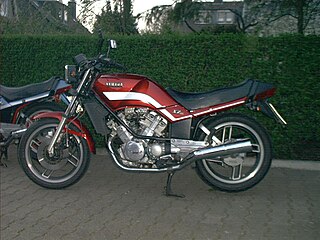
The Yamaha XZ550 'Vision' is a 550 cc V-twin shaft-driven sport touring motorcycle produced by Yamaha in 1982-1983. It was powered by a 4 stroke 70° liquid cooled 4 valve DOHC engine and featured a trailing front axle and monoshock single swingarm rear. With a range of innovative technology for its class, nimble handling, and bold styling, it was widely celebrated by the motorcycle press on its introduction as a bike ahead of its time.

The Yamaha FZX750 was a motorcycle made by Yamaha from the early 1980s until the mid-1990s. The US version was the FZX700 Fazer, imported only in 1986 and 1987, with a 50 cc smaller engine displacement to avoid import tariffs on motorcycles larger than 700 cc.

The Suzuki GSX-R750 is a sports motorcycle made by Suzuki since 1985. It was introduced at the Cologne Motorcycle Show in October 1984 as a motorcycle of the GSX-R series.
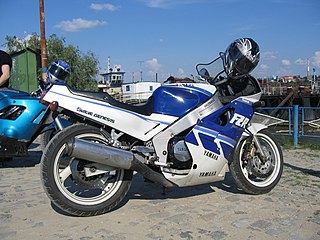
The Yamaha FZR1000 is a motorcycle produced by Yamaha from 1987 to 1995. Classed as a sports motorcycle.
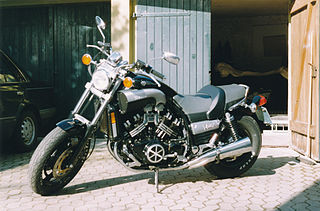
The Yamaha V-Max, cruiser motorcycle was produced by Yamaha from 1985 through 2020. Known for its 70° V4 engine, shaft drive, and distinctive styling, the V-Max was discontinued following the 2020 model year.

The Kawasaki Ninja ZX-9R is a motorcycle in the Ninja sport bike series from Japanese manufacturer Kawasaki, produced from 1994 until 2003. There were five model incarnations across two basic designs.

The Yamaha FZR600 is a sports motorcycle produced by Yamaha between 1988 and 1996. It was the successor to the FZ600 and was replaced by the Yamaha YZF600R in 1997. It had a steel Deltabox frame and swingarm, similar in appearance to the alloy Deltabox frame introduced three years earlier on the 1WG FZR400.
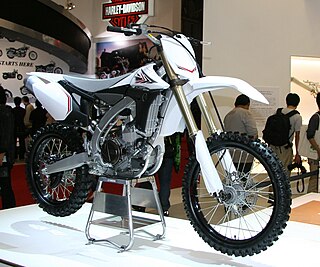
The Yamaha YZ450F is a four-stroke racing motocross bike built by Yamaha Motor Corporation. It was the successor to the previous YZ426F which was discontinued in 2003. It is credited by Cycle World and Dirt Rider magazines as the bike that started the four-stroke dirt bike revolution. The 2006 YZ250F and YZ450F were the first production motorcycles equipped with titanium suspension springs.
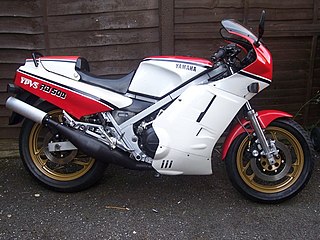
The Yamaha RD500LC is a high-performance, two-stroke sports motorcycle, also known as the RZ500 in Canada and Australia. A lightened but detuned version known as the RZV500R was developed for the Japanese home market. Strict United States Environmental Protection Agency regulations meant that the RZ500 was not available for sale in that country. Produced for a short period between 1984 and 1986 it has become a sought after collector's machine.

The Yamaha FZ750 is a sports motorcycle produced by Yamaha Motor Corporation between 1985 and 1991. The FZ750 is notable for several reasons, perhaps the most radical being the 5-valve cylinder head with a radial arrangement. This became something of a Yamaha trademark. The FZ750 would be the first bike in the Genesis design concept.

The Yamaha YZF1000R Thunderace was a motorcycle produced by Yamaha from 1996 until 2005.
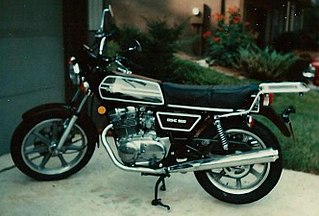
The Yamaha TX500 is a two-cylinder standard motorcycle built by Yamaha and sold in 1973 and 1974. Early models closely resembled the Triumph Bonneville in style. In 1975 the bike was renamed XS500 and then continued to be updated until 1978 when sales ended in the USA. In Europe, the model was available through 1980.
The FZ-600 was Yamaha's first true attempt at a 600 cc "Race Replica" with the growing interest in MotoGP Road Racing taking hold in the mid-1980s. Many FZ owners confuse their bikes with the later FZR models due to similar name and body styling.



















